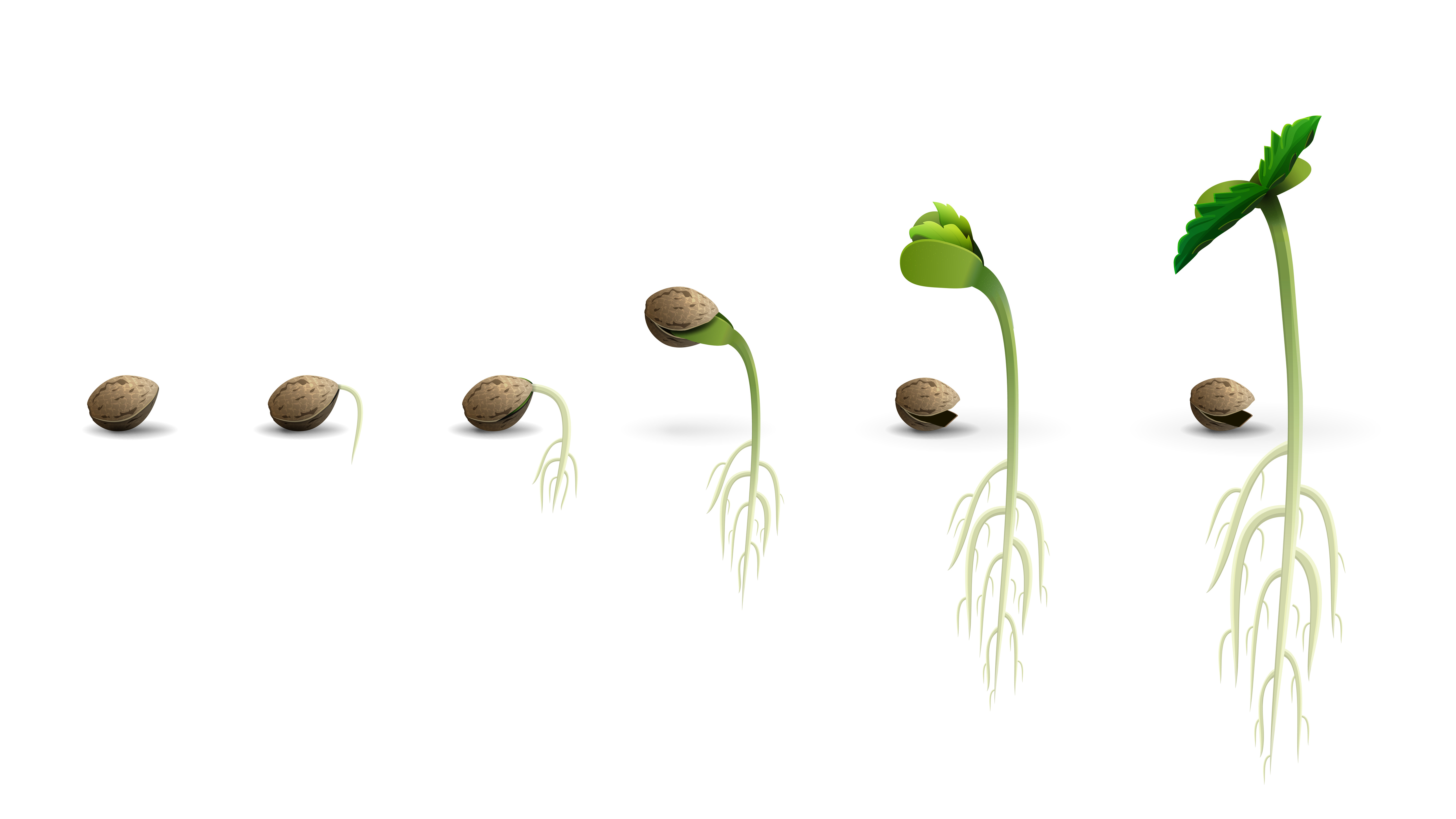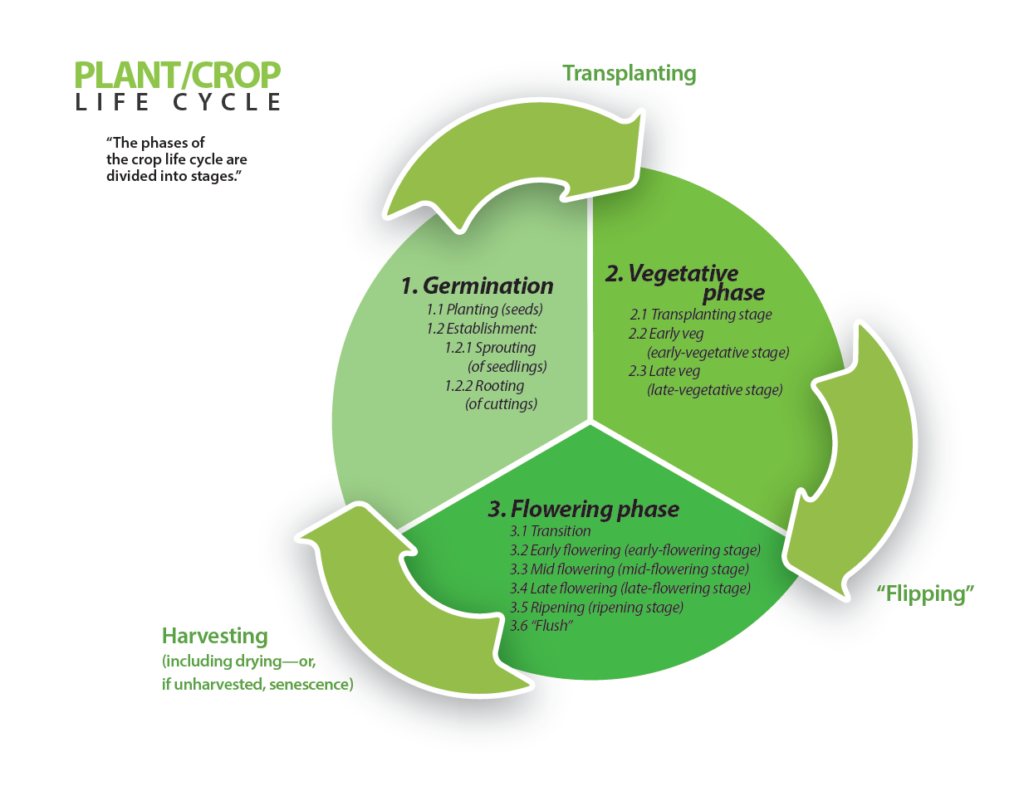
- April 4, 2024
- 0 comments
- 460 Views
In the wild, cannabis goes through three phases during its life cycle: (1) seeds germinate and seedlings sprout from seed; (2) the young plants grow vegetatively, marked by the proliferation of roots, stems and leaves; and (3) the plants mature, budding and flowering or ripening, until they reach sexual maturity, when they drop seed.[1]
Understanding the crop life cycle is important for commercial cannabis production. Unless a grower grows an auto-flowering variety, light is the main driver of the “flip” between the vegetative and flowering phases. Identifying which phase the plant is currently in is also important for providing the ideal temperature and humidity to support optimal plant development and health.
Because not every grower starts cannabis production from seed, we will focus on the phases that occur after seedling germination: vegetative and flowering.

[1] We call a plant such as cannabis that completes its life cycle in a year an “annual”; the timing of maturity of annuals depends on the specific species, variety and geographical location in which they grow.
Vegetative phase
It is in the “veg” phase that a cannabis plant establishes its structure, gradually increasing the number of its leaflets, shoots and root hairs, the length and width of terminal and lateral leaves and roots, as well as the leaf area, the number of shoots and the overall root mass—all to capture resources such as nutrients and water and to maximize photosynthesis.
Growers can determine that cannabis is “vegging” when the plant grows seven sets of true leaves, with the eighth leaf emerging at the SAM (shoot apical meristem), which is the center and apex of the growth tip. The presence of axillary buds[1] and leaflets at nodes[2] two to four indicate that the plant remains a juvenile, while the emergence of stipules at nodes five and six signify its transition to maturity.[3]
Unless it is an auto-flowering variety, the plant requires long photoperiods[4]—ideally 18 hours, but it can range from 12 to 24—to maintain vegetative growth. Growers can adjust the period to increase or decrease the time spent in veg, depending on the desired plant growth and yield. A vegetative fertilizer—often called a “grow” mix by nutrient manufacturers— that is comparatively higher in nitrogen than in phosphorus or potassium is recommended for supporting the vegetative phase, along with an environment of 25—30°C and humidity of 60—75%.[5]
[1] These are the buds seen where branches meet with the stem and may eventually become new branches.
[2] A node is where two branches intersect with the stem.
[3] https://doi.org/10.3390/plants12203646
[4] A photoperiod is the length of time a plant is exposed to light.
[5] https://doi.org/10.3389/fpls.2020.00958
Transition to flowering: pre-flowering

The earliest that cannabis can produce pre-flowers (i.e., bud sites) is around four weeks into veg. Technically, the pre-flowering phase is the first stage of the flowering phase, but given its importance in cannabis production, many consider it a sub-phase or a separate phase. Growers also refer to it as the transition stage—or say that they are “flipping” the plant. Indoor growers cultivating photoperiodic varieties can trigger the flowering phase by keeping the photoperiod to less than 12 hours, replicating the shortening daylight of the natural autumn season.
Since cannabis is a dioecious species,[1] the transition stage is crucial for growers; it is the earliest opportunity to determine the sex of each plant.[2] About six weeks into veg, growers can tell whether the new buds are male or female. Male plants produce pollen sacs that are round and usually grouped together in dense clusters, while females grow pre-flowers: two white, fuzzy, hair-like structures.[3]
Pre-flowers, also known as solitary flowers, are one indication that the plant is shifting to reproduction. As the plant receives less light, compacted inflorescences—the arrangement of flowers in females—begin to emerge in the apical regions of the main stem, as well as on the secondary- and tertiary-order branches. Inflorescence development is characterized by a reduction in branchlet length, an increase in internode density, and the clustering of solitary flowers.[4] Other signs include the growth of foliar leaves and bracts, particularly at nodes seven through twelve.[5]
[1] Having male reproductive organs in one individual and female in another.
[2] Unfertilized, seedless flowers contain the highest amount of cannabinoids, so growers raising cannabis for medicinal or recreational purposes will need to remove any males to avoid pollination and seed development.
[3] https://extension.usu.edu/crops/research/ten-frequently-asked-questions-about-growing-cannabis
[4] https://doi.org/10.3390/plants12203646
[5] https://doi.org/10.3390/plants12203646

Figure 1. Morphological characteristics of cannabis during the vegetative phase and the flowering phase, respectively: (A) the two stipules—small, leaf-like structures found at the base of a petiole—of a juvenile plant; (B) bracts—modified leaves found just below a flower—and solitary flowers.[1]
Image Source: Plants 2023, 12(20), 3646
[1] Plants 2023, 12(20), 3646
Flowering phase
Figure 2. Flowering progress in cannabis: the main flower after (A) 3 days, (B) 1 week, (C) 2 weeks, (D) 4 weeks, (E) 6 weeks and (F) 8 weeks.
Image source: Plants 2023, 12(20); https://doi.org/10.3390/plants12203646

The flowering phase is when buds develop their highest levels of cannabinoid content during the crop life cycle. Responding to the sharp decrease in daylight as if death were imminent, annuals commence flowering rather quickly—within 10 to 15 days—starting with the pre-flowering stage previously described. Glandular trichome density increases and becomes apparent shortly after the photoperiod is shortened.
The flowering phase can be broken into three stages in addition to the transition stage:
- Early flowering: The plant builds the framework for future bud sites, and pistils (hairs) begin to emerge.
- Mid flowering: The plant concentrates on the maturation and enlargement of buds.
- Late flowering/ripening: The plant maximizes its production of cannabinoids and terpenes, resulting in potent, flavorful buds.
Differences between seed, clone and tissue-culture propagation
While flowers develop, growers also witness the emergence of glandular trichomes on the bracts encasing the ovary during flower development. This marks the beginning of resin production, a characteristic feature of cannabis flowers.
The flowering phase can last between six and 12 weeks, and timing of flower maturity depends on the variety and environmental conditions. During this time, the temperature should be maintained between 25—30°C and humidity should be reduced to 50—55%. The plant also requires higher light intensity, greater carbon dioxide concentration and a nutrient ratio balanced more toward phosphorus and potassium than nitrogen.
After the flowering stage, the buds are ready for harvest!
The Emerald Harvest Team